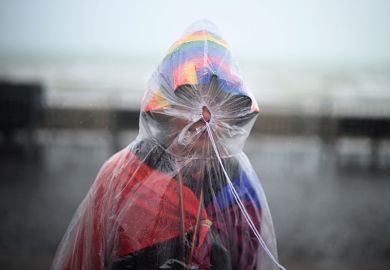Kurt Vonnegut maintained that it was harder to write comedy than history. The comic writer has to construct every perception, to invent every sentence, whereas the historian can waffle on for pages about a single idea - which does not even have to be his own. No one could accuse Simon Schama of waffling. His prose is full of meaty stuff, and every scrap of it is backed by deep and thorough research.
For all its density, though, there is something missing. Schama proceeds by metaphor and anecdote, like a novelist, but he is a historian of the first water, and would not repeat a story in print without checking his sources. Sometimes, reading the intricate histories of the protagonists of Schama's stories, and his exceptionally intimate unravellings of their motives, I found myself thinking that the methods of history and the methods of anecdote are just plain incompatible, in spite of all the attempts that are made to combine them. With the ancient writers, like Pliny and Plutarch, anecdote is everything; character sketches, ludicrous notions, astonishing assertions are all put into the pile of life as if to say, here! Sort it out yourself! With Schama, a modern, well-resourced historian, the anecdote is a bit like hearing a comedian who explains all his jokes - it is less fun, because it is unimpeachable. What you miss is a little more speculation.
Is that prejudice? Let me start again, by saying what this fascinating book is about. I quote from the introduction, which is a moving and inspiriting piece of work. The cultivation that has changed the wilderness has changed nature for us: "It has been happening since the days of ancient Mesopotamia. It is coeval with writing, with the entirety of our social existence. And it is this irreversibly modified world, from the polar caps to the equatorial forests, that is all the nature that we have.'' We are not ruined, however. The things we have done to the world are not a simple matter of exploitation, they have a profundity that touches our origins. The kick in the argument is that our earth shaping impulses, put together over 10,000 years, do not exclude us from being friends of the earth.
"Landscape and Memory tries to be a way of looking . . . of rediscovering what we already have, but which somehow eludes our recognition and our appreciation. Instead of being another explanation of what we have lost, it is an explanation of what we may yet find.'' It sounds American, doesn't it? It is an enduring theme in American culture, this urge to rediscover what we know but have temporarily forgotten. Schama is deeply European but he is also Old Dominion professor of the humanities at Columbia University, and his introduction has the timbre of an American tract. It has that optimistic energy you need if you have got to backtrack.
Schama sets out to rediscover our landscape myths by setting up a structure of landscape fundamentals. The book is divided into three sections, "Wood", "Water", "Rock"; the forests, rivers and mountains that he says have figured repeatedly in all our trials with nature. This trio is followed by a fourth, "Wood/Water/Rock, or Arcadia Redesigned", which describes attempts made to recreate the complete occidental landscape. In his introduction, he pictures himself as a child standing in the river of time, like the rest of us - and the whole work is bracketed, as the first thing and the last, by a quote from Thoreau. "It is in vain to dream of a wilderness distant from ourselves. There is none such. It is the bog in our brains and bowels, the primitive vigour of nature in us, that inspires that dream.'' Against this structure Schama parades the stories of a succession of landscape enthusiasts: Gutzon Borglum, the sculptor of Mount Rushmore and Ku Klux Klan member; Walter Ralegh, here for his obsession with Orinoco gold: Claude Denecourt, the "inventor of hiking'' who mapped out paths for the people in the forest of Fontainebleau. There is an essay on Bernini's Fountain of the Four Rivers, and the story of the first Alpine explorations undertaken by seekers of the sublime. There is an appreciation of Courbet's erotic painting - in the water section, as a sub-story to the description of William Rush's allegorical water nymph fountain for the Schuylkill water works in Philadelphia in 1800. The more I list, the more there is. There is masses and masses of it. some of the characters are familiar - but he is so thorough that from now on they will all be Schama's people.
So what is missing? Can it be speculation? That is what struck me when I read his account of Dinocrates, who presents to Alexander the Great a scheme for a colossal statue of himself, carved out of a whole mountain, so big that it has room for a city to sit on its palm. Schama presents this as a clumsy effort, saying - referring to Vitruvius - that Alexander ridiculed the impossible economics of a city halfway up a colossus, but nevertheless employed Dinocrates to work on Alexandria. Speculation includes the possibility that the whole exercise was a stunt for exactly that end - Alexander founded cities every time his army halted for rest - it could have been the city, not the statue, that was Dinocrates's hook. But is such a speculation legitimate for a historian? Schama is aware of the problem - he has written on the subject in Dead Certainties - but why continue the ambiguity? Why not stand up to it? Why not study techniques? Technique is a sort of real-world parallel to narrative - a hard-edged speculation - something that is common to now and then, and is as important a connection with our origins as remembering Robin Hood. Nowhere in this book does the technique affect the outcome - everything is narrative. The most tantalising omission is that photograph of Mount Rushmore nearing completion, with ladders and cradles slung all over those huge faces, which begs the question - how do you set about making a thing of that size? And there is not a word about it.
Landscape and Memory is about landscape inside the head - not in the world. "It is in vain to dream of a wildness distant from our selves.'' In that case, where is the section called "Ice", which takes on the unwritten memories of human species who lived in the wildness 30,000 years ago? Is it that the absence of written history precludes its inclusion? In that case, where is the section called "Air", which includes Bayer naming the southern stars, Cassini's attempts to measure the solar system, and that set of sheds they call Cape Canaveral? Is that not all landscape, too?
This is an extraordinary book, compendious as the 19th-century. The bibliographical guide alone is worth the purchase price. But it leaves me wanting more.
Paul Shepheard is researching landscape themes, assisted by a grant from the Graham Foundation for advanced studies in the fine arts.
Landscape and Memory
Author - Simon Schama
ISBN - 0 00 215897 3
Publisher - HarperCollins
Price - £30.00
Pages - 652pp
Register to continue
Why register?
- Registration is free and only takes a moment
- Once registered, you can read 3 articles a month
- Sign up for our newsletter
Subscribe
Or subscribe for unlimited access to:
- Unlimited access to news, views, insights & reviews
- Digital editions
- Digital access to THE’s university and college rankings analysis
Already registered or a current subscriber? Login



